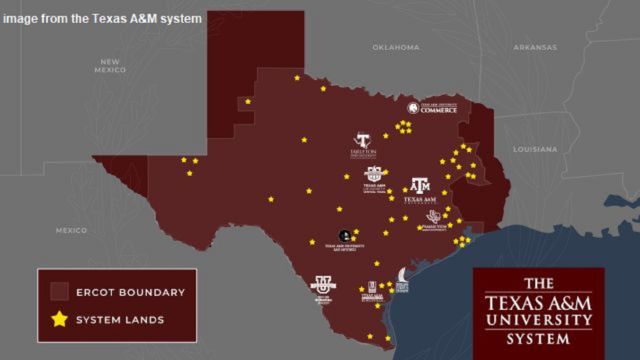
The Texas A&M system announces the creation of building a statewide network of small power plants on system properties.
Financing will come from a $5 billion dollar state fund that was created following blackouts during Winter Storm Uri.
An image produced by the system shows 55 locations where what are called peaker power plants could be built.
A system news release says several locations in the Bryan/College Station area are under consideration.
These plants would operate only during periods of peak demand.
System chancellor John Sharp says the system’s interest followed losing hundreds of millions of dollars of research during the 2021 winter storm.
Bryan mayor Bobby Gutierrez, during a visit on WTAW’s The Infomaniacs, said the city and Bryan Texas Utilities (BTU) have been working with system officials on this project.
Click below to hear comments from Bobby Gutierrez, visiting with Scott DeLucia on WTAW’s The Infomaniacs May 22, 2024:
News release from the Texas A&M system:
The Texas A&M University System today took its first steps toward creating a peaker power network on land it owns across the state to help stabilize the Texas power grid during peak demand.
There are several possible sites in the Bryan, College-Station area under consideration.
Peaker power plants, also known simply as “peakers,” are power plants typically used to provide electricity during periods of peak demand. They are an essential component of modern electricity grids, providing a reliable source of power during periods of high demand.
On Tuesday, The A&M System asked private developers to submit their proposals for building peakers on A&M System-owned property with financing through the newly-created $5 billion Texas Energy Fund.
“This will help ensure our campuses and their local communities never go dark again, while adding power to help ensure all of Texas is protected,” said John Sharp, Chancellor of The Texas A&M University System.
Sharp said hundreds of millions of dollars’ worth of research were lost during Winter Storm Uri in 2021, when blackouts shut down power to labs and refrigerators across Texas.
Peaker power plants are designed to prevent blackouts by operating only during times of high electricity demand, such as hot summer days when air conditioning use spikes, or during major events that require significant energy consumption. They are not meant to run continuously but to be activated quickly when needed to stabilize the grid. They only run a few days each year.
Peaker plants also play a crucial role in integrating renewable energy sources into the grid. Since renewable sources like wind and solar are intermittent, peaker plants can provide backup power when these sources are not generating electricity.
The Texas Energy Fund was created after the blackouts of Winter Storm Uri made it clear to all that the Texas power grid didn’t have adequate generation capacity. It was created by Senate Bill 2627 in 2023 by legislation sponsored by Senators Charles Schwertner, Carol Alvarado, Paul Bettencourt and Representative Todd Hunter. Voters approved the constitutional amendment creating the Texas energy fund in November.
“We at the City of Bryan are proud to be supporting this effort that will provide stability to our electric grid in times of need assuring us that nothing like Winter Storm Uri will ever happen to Texas again,” said Bryan Mayor Bobby Gutierrez.
